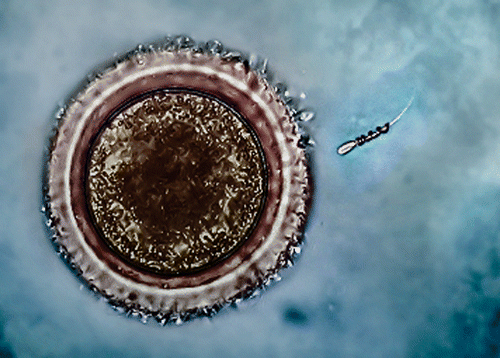'Spermbots' could help women trying to conceive (w/ Video)

Sperm that don't swim well rank high among the main causes of infertility. To give these cells a boost, women trying to conceive can turn to artificial insemination or other assisted reproduction techniques, but success can be elusive. In an attempt to improve these odds, scientists have developed motorized "spermbots" that can deliver poor swimmers—that are otherwise healthy—to an egg. Their report appears in ACS' journal Nano Letters.
Artificial insemination is a relatively inexpensive and simple technique that involves introducing sperm to a woman's uterus with a medical instrument. Overall, the success rate is on average under 30 percent, according to the Human Fertilisation & Embryology Authority of the United Kingdom. In vitro fertilization can be more effective, but it's a complicated and expensive process. It requires removing eggs from a woman's ovaries with a needle, fertilizing them outside the body and then transferring the embryos to her uterus or a surrogate's a few days later.
Each step comes with a risk for failure. Mariana Medina-Sánchez, Lukas Schwarz, Oliver G. Schmidt and colleagues from the Institute for Integrative Nanosciences at IFW Dresden in Germany wanted to see if they could come up with a better option than the existing methods.
Building on previous work on micromotors, the researchers constructed tiny metal helices just large enough to fit around the tail of a sperm. Their movements can be controlled by a rotating magnetic field. Lab testing showed that the motors can be directed to slip around a sperm cell, drive it to an egg for potential fertilization and then release it. The researchers say that although much more work needs to be done before their technique can reach clinical testing, the success of their initial demonstration is a promising start.
Watch the spermbots at work in this Headline Science video:
More information: Mariana Medina-Sánchez et al. Cellular Cargo Delivery: Toward Assisted Fertilization by Sperm-Carrying Micromotors, Nano Letters (2015). DOI: 10.1021/acs.nanolett.5b04221
Abstract
We present artificially motorized sperm cells—a novel type of hybrid micromotor, where customized microhelices serve as motors for transporting sperm cells with motion deficiencies to help them carry out their natural function. Our results indicate that metal-coated polymer microhelices are suitable for this task due to potent, controllable, and nonharmful 3D motion behavior. We manage to capture, transport, and release single immotile live sperm cells in fluidic channels that allow mimicking physiological conditions. Important steps toward fertilization are addressed by employing proper means of sperm selection and oocyte culturing. Despite the fact that there still remain some challenges on the way to achieve successful fertilization with artificially motorized sperms, we believe that the potential of this novel approach toward assisted reproduction can be already put into perspective with the present work.
Journal information: Nano Letters
Provided by American Chemical Society




















